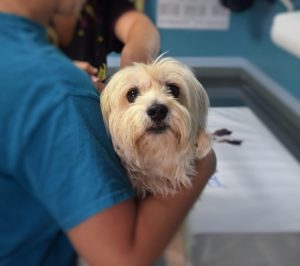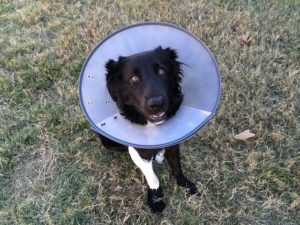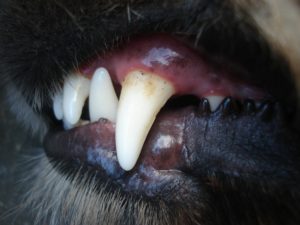Is My Dog Sick? 15 Symptoms You Shouldn’t Overlook

Dogs are masters at hiding when they aren’t feeling well. As a result, it may be difficult for pet owners to determine when their pup is under the weather. So how can pet owners figure out when their dog is sick?
Here are 15 symptoms your dog may exhibit that warrant a trip to the vet:
1. Drooling or Stinky Breath
All dogs drool and it’s almost impossible to find a dog that has fresh breath. But when does drooling and bad breath become a medical problem? If you notice your dog’s breath is stinkier than normal or they are drooling more than usual, it could mean your dog is having dental issues.
Like people, dogs can suffer from poor oral hygiene and periodontal disease. This can cause increasingly bad breath and excessive drooling. The buildup of tartar and plaque inside your dog’s mouth can produce bacteria that lead to bad breath. You can usually see the buildup by checking for browning on the teeth, red and swollen gums, or even bleeding.
2. Increase in Water Intake or Going Potty Frequently
Excessive drinking and urination can be a sign of disease. The most common include kidney failure, diabetes mellitus, and Cushing’s disease. These are very serious diseases that should be addressed as soon as possible. To stop excessive thirst and urination, your vet must diagnose the underlying condition. Once diagnosed, most conditions can be regulated.
But how do you know when your dog is drinking too much water? Generally, a dog should drink between 20-70ml per day. Keeping an eye on your dog’s drinking habits can make you more aware of excessive drinking.
3. Appetite Change
Dogs are usually enthusiastic about food. When your dog loses interest, it can be pretty worrisome. There are numerous reasons a may stop eating, such as illness, dental disease, recent vaccinations, stress, or something more serious like kidney failure. Other symptoms that may accompany a loss of appetite can include weight loss, lack of energy, and vomiting.
Alternately, disease or bacteria can cause an increased appetite. A few common diseases are diabetes, hyperthyroidism, and Cushing’s disease. All of these diseases result in an increased appetite. Along with a newfound hunger, your dog will drink more frequently which will cause him to go potty more. If left untreated, your dog will begin to gain weight.
If your dog is eating frequently but losing weight, he may be suffering from a gastrointestinal problem such as insulin deficiency, inflammatory bowel syndrome, or intestinal cancer. These will cause malabsorption in your dog. Along with weight loss, your dog will suffer from diarrhea and vomiting.
4. Lethargy
Lethargy is one of the vaguest symptoms of illness in a dog. It can be caused by several things, such as medications, infection, or disease. You’ll notice  when your dog is lethargic because he will have a lack of energy and show little to no interest in his toys, playing, or going outside.
when your dog is lethargic because he will have a lack of energy and show little to no interest in his toys, playing, or going outside.
If lethargy is the only symptom your dog has, he or she could be anemic. If the anemia is severe, your dog’s gums will be pale. Canine distemper, parvovirus, heart disease, heartworm, or pain can also cause lethargy. However, remember that as your dog gets older, lethargy is normal.
5. Mobility Issues
Stiffness, difficulty rising, and reluctance to climb stairs are usually exhibited by elderly dogs, However, younger dogs can injure themselves and suffer the same symptoms. Either way, a vet visit is required. These painful symptoms in elderly or overweight dogs are commonly caused by wear and tear that causes damage in the joints, leading to arthritis.
6. Changes in Breathing
Diseases in the respiratory system can cause difficulty breathing, coughing, or abnormal panting in your dog. The best way to determine if your dog is having breathing problems is to know your dog’s breathing habits. Is it normal for your dog to struggle to breathe? Brachycephalic breeds struggle to breathe because of their face’s flat structure. How does your dog breathe during low activity or at rest? Does he only breathe heavily when excited or while panting? Knowing these things will keep you more aware when there is a problem.
There are many symptoms associated with difficulty breathing, but some of the more common ones are:
- Coughing
- Shortness of breath
- Noisy breathing
- Difficulty breathing
- Constant panting
- Foam coming from the mouth
Difficulty breathing should always be treated as an emergency, so you should take your dog to the vet immediately if he is showing any of these symptoms.
7. Upset Stomach
There are many reasons a dog may have an upset stomach. These can include parasites, viruses, bacteria, food sensitivity, and even stress or anxiety.  Dogs aren’t picky eaters and they don’t think about what they are about to eat before actually eating it. This can lead to tummy troubles.
Dogs aren’t picky eaters and they don’t think about what they are about to eat before actually eating it. This can lead to tummy troubles.
Diarrhea and/or vomiting are caused by inflammation, either in the stomach or intestines, and result in an upset stomach. If your dog has diarrhea or vomiting for more than a few hours, a vet visit is needed. If it’s less frequent, but continues for more than 24 hours, you should also take your dog to the vet because to prevent dehydration. If you ever see blood in your dog’s diarrhea or vomit, take your pup to the vet immediately.
8. Pain
Many things can cause your dog pain. He could be suffering from an injury, arthritis, infection, or disease. No one wants their dog to be in pain. While it seems like it would be obvious to tell if your dog is in pain, dogs are not always vocal when it comes to their pain. Fortunately, there are signs that you can watch for so your dog doesn’t suffer in silence.
Sometimes when dogs are in pain they groom themselves excessively. If your dog is licking his paws frequently, it could be because he is suffering from arthritis and is licking to soothe the pain.
Another sign to watch for is a change in behavior. Your dog might not be as happy to see you and may even shy away from your attention, hide from you, or become aggressive. On the other hand, he could become increasingly needy and seek comfort from you.
Watch for other signs like decreased appetite or water consumption, lethargy, going potty in the house, being more vocal, or shaking. These are all symptoms that your dog may be suffering and needs to be seen by a vet.
9. Lumps and Bumps
Like people, dogs can grow lumps and bumps. And, just like people, lumps and bumps should be checked to make sure they are not serious. It’s best to check your dog regularly for growths so you can address them quickly. Watch for growths that appear suddenly, grow quickly, or change in shape or color since these are indicators that something may be wrong.
There are many types of lumps and bumps. Some can be fatty tumors that are not cancerous. Others may be superficial, such as cysts, and will likely drain and heal on their own. There are also lipomas which are a soft round mass just under the skin that are usually benign. Although these lumps and bumps usually don’t need to be removed, they should be monitored closely for any changes.
Other common lumps and bumps are:
- Warts
- Abscesses
- Blood blisters
- Hives
- Infected hair follicles
- Tumors
The only way to know for sure if your dog’s lump or bump is dangerous is to have it biopsied.
10. Eye Changes
Cloudy eyes usually appear in older dogs. But, regardless of age, you should take your dog to the vet if you notice cloudiness in their eye(s). Cloudiness can range from something minor, like nuclear sclerosis, to something more serious like cataracts or glaucoma.
Symptoms that can accompany cloudiness include:
- Squinting
- Watery eyes
- Red irritation in the whites of the eyes
- Bulging eyes
- A blue or red coloration to the cloudiness
Other eye conditions common in dogs include excessive tearing, bloodshot or red eyes, and conjunctivitis, or pink eye, which is an inflammation of the outer membrane of the eyeball and inner lid. Along with discharge, your dog may also have excessive tearing, red eyes, or inflammation. He may start to squint or just keep his eyes closed if he is uncomfortable.
11. Fever
It’s not always easy to tell when your dog has a fever, and just feeling his nose is not very accurate. Luckily there are more telltale signs to look for. Symptoms of fever in a dog can include:
- Red eyes
- Loss of appetite
- Warm ears
- Lethargy
- Shivering
- Coughing
- Vomiting
A fever is usually a sign of an infection in a dog, so it is important to keep an eye on him and take him to the vet if necessary. However, if your dog has recently been vaccinated a low-grade fever is expected and can last 24-48 hours.
12. Itchiness
There are numerous reasons for dogs to itch. Along with frequent itching, you may also notice head shaking, chewing, and sometimes licking. Not only is itching uncomfortable for your dog, it can also cause dry inflamed skin or an infection.
One common reason for itchiness is allergies. Dogs can be allergic to the same things as people except their allergies appear in the form of watery eyes and frequent  itching. If your dog tends to get itchy every spring, he may be suffering from allergies.
itching. If your dog tends to get itchy every spring, he may be suffering from allergies.
Dry skin is another common reason for itchiness in dogs. It’s easy to tell if your dog has dry skin. Just part their fur and look for any type of flaking. Dry skin usually flares up when the seasons change.
Parasites, especially fleas, ticks, and mites, are another common cause for itchiness in your dog. It’s hard to tell if your dog has parasites just by looking because not all parasites are visible. Ticks are usually visible, so check your dog thoroughly. Additionally, a mite infestation can also result in hair loss. Your dog will most likely be itching in areas that are already mostly hairless, such as armpits, belly, and ears.
13. Restlessness
Dogs tend to be restless when they are excited or bored. But how do you know when it’s a medical problem? If your dog is pacing excessively or changing positions frequently, something could be wrong.
Sometimes a restless dog has behavioral issues. If others notice your dog is restless after you leave the house, your dog is probably suffering from separation anxiety. If he becomes restless after hearing loud noises, it could be fear causing the nervousness. Pay attention to your surroundings when your dog gets restless. Is something upsetting him?
Sometimes restlessness is due to medical issues. If your dog is in pain, he or she may have a hard time getting comfortable and could pace or change positions frequently. Cushing’s disease, common in older dogs, causes restlessness because it overproduces cortisol.
Other reasons for restlessness could include parasites, chocolate poisoning, or even Alzheimer’s.
14. Gum Paleness
 Pale gums in dogs can be a sign of health problems and should always be taken seriously. Your dog’s gums should be a nice healthy pink. Some dogs have dark patches on their gums so just look at the surrounding pink areas. Knowing what your dog’s gums look like when they are healthy is important for later comparison.
Pale gums in dogs can be a sign of health problems and should always be taken seriously. Your dog’s gums should be a nice healthy pink. Some dogs have dark patches on their gums so just look at the surrounding pink areas. Knowing what your dog’s gums look like when they are healthy is important for later comparison.
15. Difficulty Balancing
Ear infections, stroke, or an injury that results in brain inflammation can cause balance issues in your dog. When your dog has difficulty balancing, they may stagger frequently, have weak limbs, or fall.
If your dog has an ear infection, he may also shake or tilt his head, walk in circles, or have eyes that move uncontrollably. Sometimes you can tell if your dog has an ear infection because his ear will appear swollen, have a discharge, or smell bad.
Strokes are less common in dogs, but they can still suffer from them. Along with balancing issues, your dog may become extremely lethargic and lose control of his bladder or vomit.  If you believe your dog may be having a stroke take him to the vet immediately because his symptoms will only get worse.
If you believe your dog may be having a stroke take him to the vet immediately because his symptoms will only get worse.
Besides these common symptoms, look into medical conditions that are common in your dog’s breed so you know what signs to look for. Keep an eye on your dog’s behaviors and habits so you can tell when he is doing something out of the ordinary. If you notice an abnormal change, take your dog to the vet. It’s always better to catch a serious problem early before it progresses. Even if it ends up being nothing, at least you have peace of mind that your dog is okay.

I found it helpful when you explained that if a dog is restless more that it regularly is, then that might be a sign it is sick. My dog normally doesn’t have any problems sleeping, but lately, he has been keeping me up at night because he doesn’t sleep for more than an hour. It seems like it would be a good idea for me to take him to a veterinarian so that I can find out what is wrong with him.
It’s good to know that lethargy and shivering may indicate that your dog has a fever. My Yorkie has been very shivery, low-energy, and uninterested in food for the past 36 hours. I will definitely take her to a local vet to have that checked out as soon as possible.